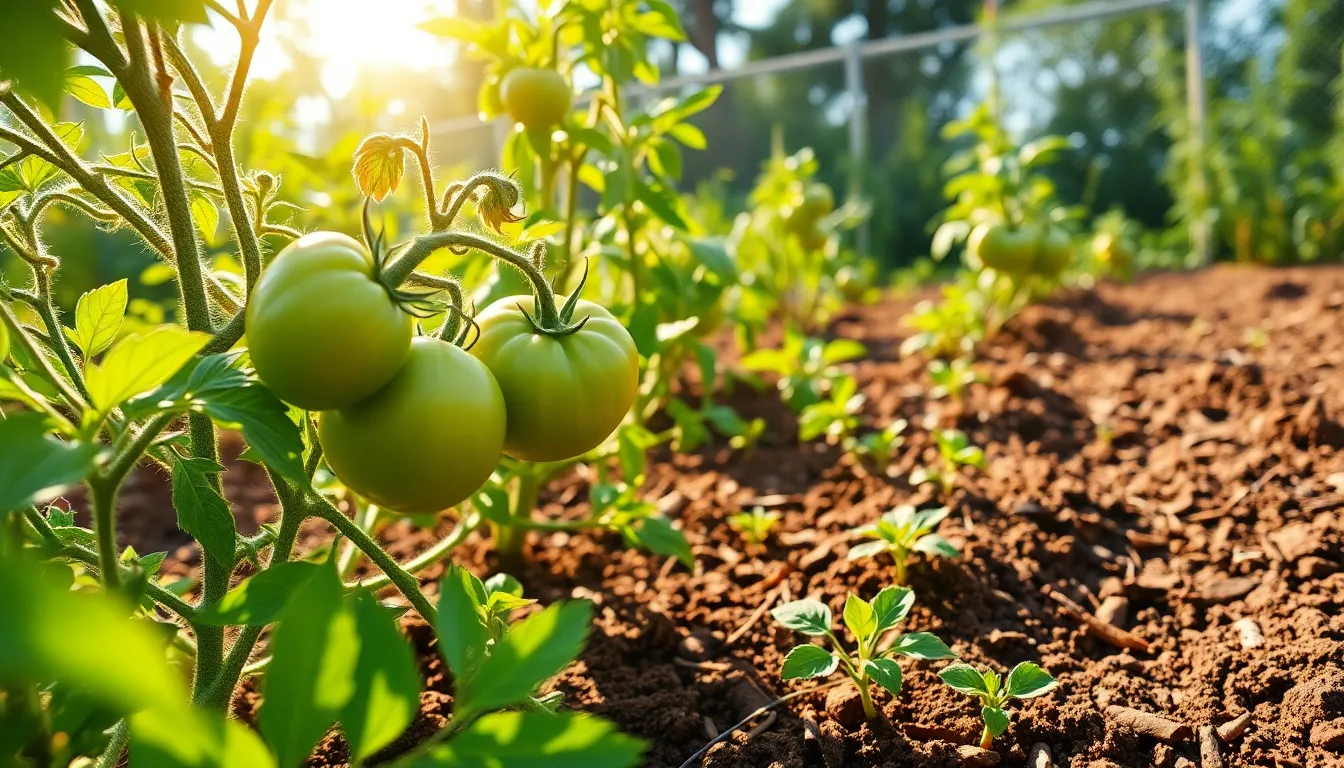Table of Contents
ToggleGrowing tomatoes isn’t just a hobby; it’s a rite of passage for any aspiring gardener. Who wouldn’t want to pluck a bright red, juicy tomato straight from their backyard and toss it into a salad or slice it for a sandwich? With their vibrant color and mouthwatering taste, tomatoes can turn any meal into a culinary masterpiece.
Understanding Tomato Varieties
Choosing the right tomato variety plays a crucial role in successful gardening. Different types offer unique flavors, growth habits, and uses.
Determinate vs. Indeterminate
Determinate tomatoes grow to a fixed height, typically 3 to 4 feet, and produce fruit in a short, concentrated period. Cultivators find these varieties ideal for canning and preserving since all the tomatoes ripen at once. Indeterminate tomatoes continue growing and producing fruit throughout the season. They can reach heights of 6 feet or more, making them suitable for fresh eating throughout summer. Tomato lovers enjoy the extended harvest from indeterminate types.
Heirloom vs. Hybrid
Heirloom tomatoes are open-pollinated varieties known for their rich flavors and unique colors. Gardeners appreciate their cultural history and often prefer them for home gardens. Hybrid tomatoes result from controlled pollination between two parent plants, resulting in characteristics like disease resistance and higher yields. Farmers often choose hybrids for commercial purposes due to their consistent quality and robustness. Each type appeals to different gardening preferences and culinary needs, enriching the tomato-growing experience.
Preparing Your Garden

Preparing the garden for tomato cultivation ensures optimal growth and bounty. Attention to detail in location and soil makes a significant difference.
Choosing the Right Location
Select an area receiving at least 6 to 8 hours of sunlight daily. Good air circulation contributes to plant health and reduces disease risk. Proximity to water sources simplifies irrigation. Avoid low-lying areas prone to cold air and frost. Consider planting near taller plants for partial shade during intense heat. Assess soil drainage, as excessive water can lead to root rot. Accessibility for maintenance and harvesting enhances the gardening experience.
Soil Preparation Techniques
Test the soil pH, targeting a range of 6.0 to 6.8 for optimal growth. Amend the soil with organic matter such as compost to improve nutrient content and drainage. Incorporate balanced fertilizers before planting to provide necessary nutrients. Turn the soil to a depth of 12 inches, breaking up clumps to enhance aeration. Mulching retains moisture and suppresses weeds once plants establish. Maintain soil health through periodic testing and amendments for ongoing tomato vitality.
Planting Tomatoes
Planting tomatoes involves careful timing and technique for optimal growth. Gardeners typically find success by adhering to specific guidelines.
When to Plant
Timing affects tomato growth significantly. The ideal planting time varies by climate but generally falls between late spring and early summer. Soil temperatures should reach at least 60°F before planting. Frost-free dates are crucial in determining the best time to start. Observing local weather patterns helps gardeners plan effectively. Early varieties may be planted sooner, while late-season types thrive when soil warms consistently.
How to Plant Seeds or Seedlings
Choosing the right method for planting affects tomato health. Seeds can be sown indoors 6 to 8 weeks before the last frost date. Using seed trays with a quality seed-starting mix enhances germination rates. When planting seedlings, space them 18 to 24 inches apart in prepared soil. Digging a hole deep enough to bury the stem encourages root growth. Watering thoroughly after planting ensures seedlings settle well. Mulching around plants helps retain moisture and suppress weeds effectively.
Caring for Your Tomato Plants
Caring for tomato plants involves consistent attention to their needs. Each aspect, from watering to pruning, plays a crucial role in achieving healthy growth.
Watering Guidelines
It’s essential to maintain consistent moisture in the soil for tomato plants. Aim for at least 1 to 2 inches of water weekly, ensuring even distribution. Watering should occur early in the day to reduce evaporation. When plants begin to bear fruit, deep watering encourages stronger root systems. Preventing water stress is key, as it can lead to blossom end rot. Monitoring the soil moisture level helps determine when to water.
Fertilizing Your Tomatoes
Fertilizing directly influences the growth and yield of tomato plants. Start with a balanced fertilizer at planting, such as a ratio of 10-10-10. Nutrients like nitrogen support healthy foliage, while phosphorus aids root development. After the plants set fruit, switch to a fertilizer higher in potassium. Monthly applications support continued growth and fruit production. Tracking the nutrient needs based on soil tests can further optimize fertilization strategies.
Pruning and Supporting Your Plants
Pruning tomato plants promotes better air circulation and encourages fruit production. Remove suckers that grow in the leaf axils to direct energy toward fruiting. Supporting plants with cages or stakes ensures stability and prevents sprawling. Adequate support reduces disease risk and simplifies harvesting. Regularly check for damaged leaves and remove them to maintain plant health. Each pruning session enhances air flow and light exposure.
Dealing with Pests and Diseases
Managing pests and diseases is crucial for healthy tomato plants and optimal yields. Not addressing these issues early can lead to significant crop loss.
Common Tomato Pests
Aphids, whiteflies, and spider mites frequently invade tomato plants. These pests damage foliage and compromise plant health. Observing plants regularly helps identify early infestations. Beneficial insects, like ladybugs, effectively control aphid populations. Neem oil acts as a natural pesticide, offering effective prevention against several pests. Utilizing insecticidal soap helps manage outbreaks by targeting soft-bodied insects. Maintaining plant health through proper watering and fertilization strengthens plants against pest attacks.
Preventing Tomato Diseases
Fungal diseases, such as blight and wilt, threaten tomato crops. Practicing crop rotation reduces the risk of disease recurrence. Choosing disease-resistant varieties provides an added layer of protection. Proper spacing between plants improves air circulation, essential for preventing fungal growth. Regularly removing debris and diseased plant material limits the spread of pathogens. Applying mulch around plants helps prevent soil-borne diseases. Monitoring weather conditions allows for timely action against potential disease outbreaks.
Harvesting Your Tomatoes
Harvesting tomatoes at the right time enhances flavor and texture. Recognizing when to pick them ensures the best culinary experience.
Signs of Ripeness
Color plays a crucial role in determining tomato ripeness. Look for vibrant, deep hues, which differ depending on the variety. Firmness indicates readiness; gently squeezing can reveal whether a tomato is ready for harvest. Fragrance also hints at ripeness; a strong, sweet aroma suggests a mature tomato. Gather tomatoes on the vine continuously as they ripen for optimal quality.
Best Practices for Harvesting
Using sharp scissors or pruners prevents damage when cutting tomatoes from the vine. Grasping the fruit gently avoids bruising. Harvest early in the morning or late in the afternoon when temperatures are cooler to enhance flavor retention. Store harvested tomatoes at room temperature, avoiding refrigeration, which compromises taste and texture. Regularly check plants to ensure timely harvesting, promoting continued production.
Growing tomatoes is a rewarding experience that brings both joy and delicious flavors to the table. By selecting the right variety and preparing the garden properly, gardeners can create an environment where tomato plants thrive. Consistent care and attention to watering, fertilizing, and pest management are essential for a bountiful harvest.
Harvesting at the right time ensures the best taste and texture, making the effort worthwhile. With patience and dedication, anyone can enjoy the fruits of their labor, transforming homegrown tomatoes into culinary delights. Embrace the journey of growing tomatoes and savor the satisfaction of a successful harvest.










